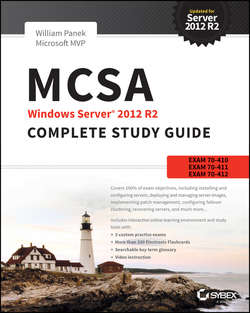Читать книгу MCSA Windows Server 2012 R2 Complete Study Guide - Panek William - Страница 14
На сайте Литреса книга снята с продажи.
Part I
Exam 70-410: Installing and Configuring Windows Server 2012 R2
Chapter 1
Install Windows Server 2012 R2
Summary
ОглавлениеIn this chapter, you studied the latest advantages of using Windows Server 2012 R2. You also learned about the different roles and features you can install on a Windows Server 2012 R2 machine. You also explored how to migrate those roles and features from a Windows Server 2008, 2008 R2, and Windows Server 2012 machine to a Windows Server 2012 R2 machine.
I discussed the different upgrade paths that are available and which upgrades are best for your current network setup. You learned that another important issue to decide when installing Windows Server 2012 R2 is whether to use Server Core or the GUI installation.
You learned how to install Windows Server 2012 R2 Datacenter with GUI, and you installed the Windows Server 2012 R2 Server Core. Remember, Server Core is a slimmed-down version of Windows Server. With no GUI desktop available, it’s a safer alternative to a normal Windows install. As discussed, a nice advantage of Windows Server 2012 R2 is that you can change from Server Core to the GUI version and back again.
I discussed a feature called Features On Demand. This feature allows you to remove roles and features from the operating system and remove the associated files completely from the hard drive, thus saving disk space.
You examined the various aspects of Windows Server 2012 R2 storage services as well as the various types of storage technologies and native Windows Server 2012 R2 storage management tools. I started the chapter by discussing initializing disks and choosing a partition type: MBR or GPT. I then discussed the types of disk configurations, dynamic and basic, that are supported in Windows Server 2012 R2. You learned that various properties are associated with each type of configuration. Then I discussed the different types of RAID and the properties of each.
The next section explored storage technologies, namely, iSCSI, Fibre Channel, and NAS. I primarily focused on iSCSI because of the native support in Window Server 2012 R2. You learned how to configure an iSCSI initiator and a connection to an iSCSI target. After that, you looked at its iSNS server and how to configure it.
The chapter concluded by looking at Storage Manager for SANs and Storage Explorer, which are built-in management tools in Windows Server 2012 R2 for storage devices and firewall settings.
